Due to the world-wide pandemic, it seems every time I go shopping, there is another hot item that is extremely hard to find, if you can find it at all. Items like toilet paper, paper towel, canning supplies, and various foods such as meat or bread have been on my “grab it if you see it” list.
So it’s no surprise then, that more and more people are attempting to make things from scratch at home. I was all excited to show my young teenage son, who is interested in cooking and baking, how to make homemade bread. A perk of quarantine, if there is one!
But, apparently my thoughts were not unique as there was a rush on even more items, making the list above grow longer. A shortage of bread, combined with boredom while stuck at home, led to shortages of ingredients for making the homemade bread that I was so eager to make.
Such as yeast. The local stores were out of it every time I tried. And what I could find online, the prices were ridiculous. Then, I found out I could make my own!
Related: How To Make Yeast For Long-Term Storage
I also found that cultivating a homemade wild yeast starter has a few more advantages than simply having it on hand, such as the following:
- More natural
- Less processed
- Inexpensive to make
- Easy to make
In addition, many people are finding that their sensitivities to baked goods are less severe with a natural yeast, rather one bought at the store with additives.
One of the easiest ways to get your own starter is to grab a scoop of a friend’s, then feed it. I will address feeding later down in the article. However, if you don’t know of anyone who has the starter, or if you just prefer to start your own from scratch, it’s quite easy and doesn’t cost much at all.
So, let’s get started on your starter!
Supplies Needed
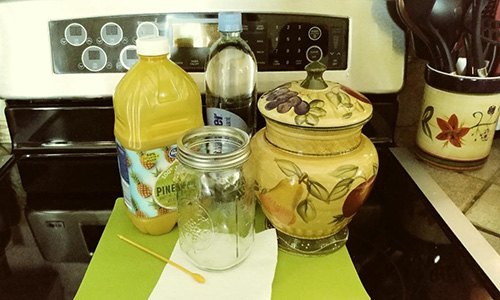 The supplies list is quite short, which is especially good when you never know what items might be hard to find.
The supplies list is quite short, which is especially good when you never know what items might be hard to find.
Here is what you will need to cultivate your own wild yeast starter:
1 Quart Jar
That is the minimum size, and will depend on how much baking you actually do in a week’s time. However, the jar should not be airtight. If you use a wax jar, remove the seal. Or, if you use a canning jar with a cap and lid, do not tighten it. You could also use a cloth or plastic wrap to loosely cover the jar when it’s sitting. Oxygen needs to be kept in, but CO2 needs to be able to get out.
Distilled Water
Water that is not distilled, or highly filtered, has chlorine in it. Chlorine will inhibit growth and actually kill your yeast.
Flour
You can use any flour for this. So, if you prefer all-purpose, or a hard white, it doesn’t matter. If your palate can tell the difference between flours, then use what you prefer for baked goods. Otherwise, just use what you have on hand.
Unsweetened Pineapple Juice (Optional)
You have the option of using pineapple juice in place of the water for the FIRST day. But, the first day only. This will add just a little natural sugar, which will help kick start your starter to act a bit faster.
The mix of ingredients (flour and liquid) is equal parts by WEIGHT. For example, I am adding 3 tablespoons of flour and 2 tablespoons of water or juice.
Day 1
Add 3 tablespoons of flour to the quart jar.
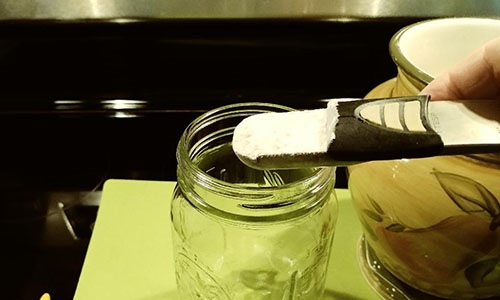 Add 2 tablespoons of water or juice to the flour in the jar.
Add 2 tablespoons of water or juice to the flour in the jar.
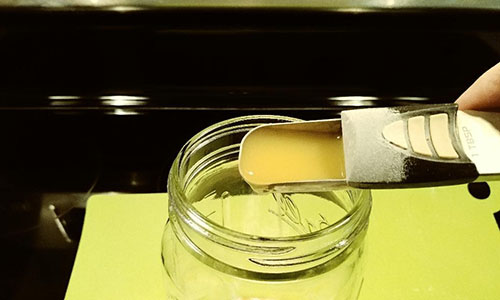 Whisk the flour and liquid together.
Whisk the flour and liquid together.
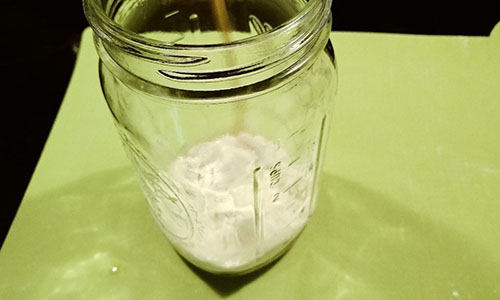 Lightly cover the jar, with an untightened lid, cloth, or plastic wrap.
Lightly cover the jar, with an untightened lid, cloth, or plastic wrap.
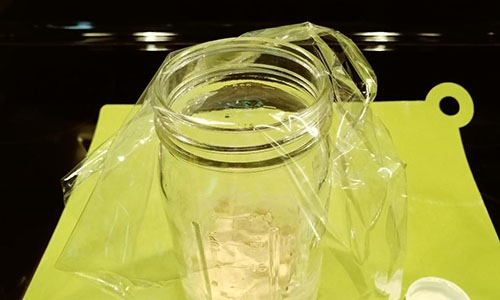 Set the jar on the counter, keeping it at room temperature, lightly stirring the mix 2-3 times within the next 24 hours.
Set the jar on the counter, keeping it at room temperature, lightly stirring the mix 2-3 times within the next 24 hours.
Day 2
Repeat the steps from Day 1, with the exception of not adding any juice. Use water in place of the juice from now on. The juice is only for day 1, if you use it at all.
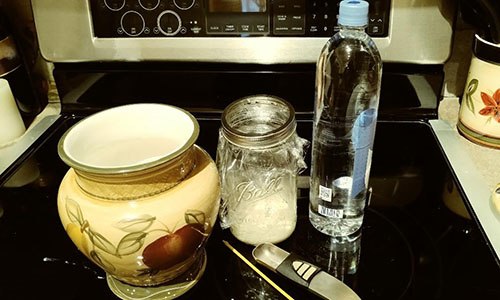 Day 3-7
Day 3-7
Repeat this process every day, adding more flour and water, and stirring 2-3 times a day. In 3-5 days, you should start to see air bubbles or pockets in the mix through the jar. At this time, you should also be able to smell a yeast aroma.
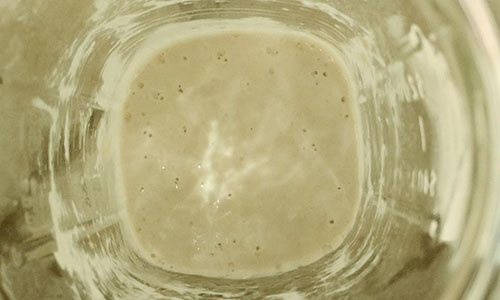 Ongoing Feedings
Ongoing Feedings
After a week, what you do next will depend on how often you bake.
If you bake about once a week, the ongoing feeding should consist of the following:
- Store the jar of yeast in the refrigerator, which will stop the growth, because you have enough now.
- Feed it once a week, by adding equal parts of flour and water by WEIGHT, basically replacing what you take out for use.
If you bake more often than once a week, the following could be done for ongoing feeding:
- Store the starter jar out on the counter.
- If there’s too much in the jar, discard or use half.
- Feed the starter daily with equal parts of flour and water by WEIGHT.
Related: 6 Backyard Plants You Can Turn Into Bread
Extra Tips
- If the starter is not active – Try switching flours, if you aren’t seeing an active yeast after a few days. Rye flour is a good choice for stubborn starter situations. Or, make sure that it’s not too cold. With cooler months, the house might be colder than normal and can slow growth. If that’s the case, store it in a warmer part of the house.
- Clear or yellowish liquid on the top – This is common, and also referred to as hooch. Since this is normal, the liquid can just be discarded if it’s just once in a while. If it’s continuous, your starter is hungry, so feed it.
- If the starter is covered with a white’ish colored film on top of a liquid – Feed it immediately, because it’s hangry, not just hungry.
- The starter goes bad – if you notice a bad smell, or see unusual coloring or fuzziness, throw it out and start over.
- If you see fruit flies or maggots in it – Discard the entire batch and start over. Try covering the new batch with a thicker cloth. Keep in mind, if you have fruit flies around, they love this stuff as much as you will!
There are many recipes, either found in your grandparent’s recipe box or on the internet, on how to use your starter for wonderful homemade baked goods. Enjoy!
You may also like:
When Grocery Stores Go Empty – A Back Door Shopping Strategy
This Bug Will Kill Most Americans During The Next Crisis (Video)
Awesome Places Where You Can Hide Your Food When SHTF

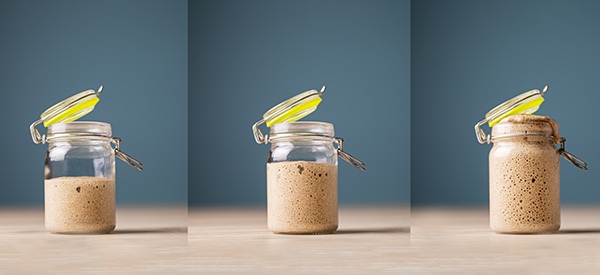





















So how much to add to bread mix?
Usually 1 cup of ripe starter for a loaf of bread. Basic recipe would be 1 cup starter, 3 – 4 cups all-purpose or bread flour, 1 cup water, 1 tbls oil, 1 tsp salt. Modify as needed for consistency
1 cup starter plus 4-5 cups flour, tsp salt. you have to knead, rest, knead, rest, allow to proof (rise) and then bake. Main thing is to be patient developing your starter. I stir the “hooch’ back in. Also, some Sour Salt (citric acid) added to the dough gives it a tangy taste.
You can get a recipe and instructions from King Arthur flour.com
Excellent article. I’m going to try this. Do you use the same amount of the homemade yeast as you do store bought in recipes?
No. One cup of ripe starter will replace 1 packet of active or instant yeast. Adjust flour and water accordingly.
Thank you, P.A.
No. Use a cup.
Thank you for many of your informative articles. FYI: Many of your links to other articles don’t work.
How to use? There must be a ratio for recipe’s compared to dry yeast. 2 to 1?, 3 to 1?.
I would like to get your book but the order form you have makes that impossible. There is no place for the town/city you live in or the country. Booth are required. According to your order for\m, you need to live in the USA. I live in Canada which seems to count me out. How do I order this book?
Hi Pythonia,
Thank you so much for your interest in our work.
I have just sent you an email with the order details.
Should you need further assistance, please don’t hesitate to let me know.
God bless,
Claude
Sorry wild yeast not with people going around with yeast infections because they do not go anywhere so they do not get dirty. These are the people that have failed hygiene 101
Huh? Is it your contention that someone with a yeast infection will contaminate your batch of home grown yeast? It would seem to me that if they don’t come in contact with your yeast brewing in the jar there is not much chance of their yeast infection getting into your batch of homegrown.
Are we to assume that following an end of the world event you are going to be subsisting strictly on flat bread, tortillas, matzo and the other unleavened breads that exist in the world because you are afraid of catching a yeast infection to use naturally growing yeast?
LCC, got a chuckle from that comment, back in the 18th century men weren’t allowed around the women folk while they churned butter, must be from the same mentality.
Will this work with gluten free flour? If so, I can’t wait to try it. Thank you!
Meg: I’m gluten intolerant and yes, it’ll work. to boost the yeast, a heaping tablespoon of raw yogurt helps. niio
If in my grandmothers’ time, a woman needed more than one pack of yeast in her life, people said she was too lazy to keep the starter going. A lot of families had their own strains of yeast kept from one generation to the next.
We don’t eat a lot of carbs, but koji is great for fermenting a lot of things, like making soy sauce. It’s activated in rice and stored for up to 6 months while active on one batch.
Best bet to keep a stain of yeast is to dry the starter or freeze it. niio
Love sourdough breads and pancakes. Good instructions.
whats: Not only that, but a lot of wild yeast is toxic. this might be why the Bible commanded Hebrews to throw out old leavening each year. But, all of us carry a lot of fungus and bacteria around. niio
RED: Japanese have been using koji for centuries to make sake, soy sauce and other fermented products. To the best of my knowledge neither sake brewers nor soy sauce brewers throw out their koji ever.
LCC: Talking Bible, not Nipon. Nor will I toss koji. It’s technically not a yeast. No place in the NT are we instructed to waste leavening. 🙂 BTW, the koji beer came out OK. I went light on the hops. niio
Thank you for this article. Wish I had it when I started the whole sourdough thing a few months back. Was using a big mixing bowl and throwing away more than I used even though I baked extra loaves and froze them. Will try again with a quart jar and all should go much better.
If you want a good yeast starter just do what they did back in old times, get some of that foam from the top of your favourite beer or ale and mix with flour and water.
https://www.youtube.com/watch?v=8J1PNDnqsfA
Getting some mold on the sides of my glass, from the stirring platters, is it too cold?
How do you use this to make wine?